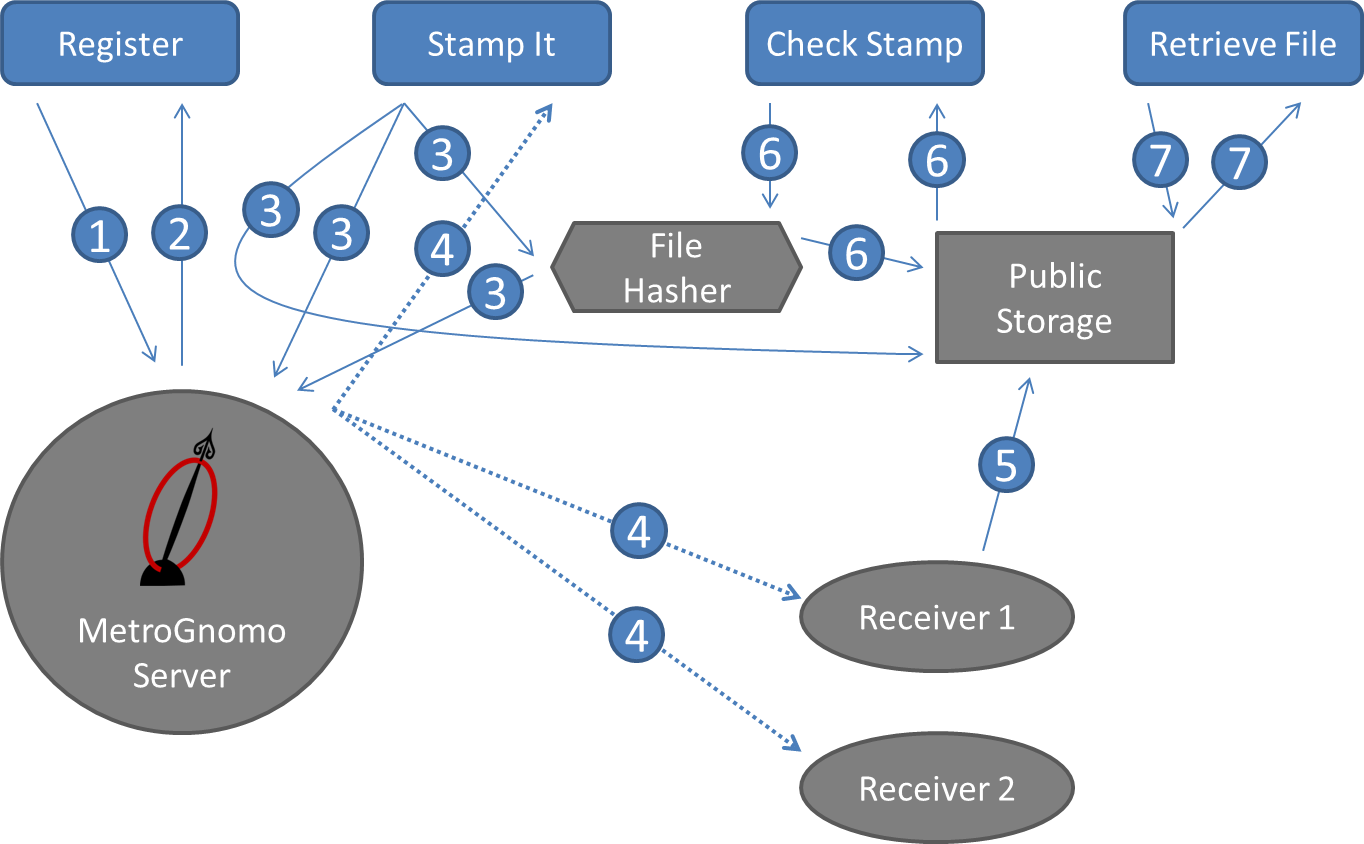MetroGnomo in Detail
MetroGnomo is an open-source experimental timestamping service based on a mutual distributed ledger (aka blockchain technology). It was the result of Z/Yen’s quest to design, and find a use for, the most stripped down mutual distributed ledger possible.
Timestamping is performed via a novel form of mutual distributed ledger (MDL) that broadcasts ledger rows to a loosely organised network of receivers. The broadcast is agnostic in that it does not know or care if there is any receipt of it by the receivers. Agnostic broadcast mode optimises the throughput of timestamps – that consist of an officially recorded time (called MetroTime), a unique universal identifier (UUID) and an optional description (such as a file hash) – and simplifies establishing and maintaining the network.
Timestamping is recording when a certain event occurs via a sequence of characters. A typical example is the delivery of a document. The term derives from ‘stamping’ documents with a seal or stamp with the current date or time in ink on paper documents. Timestamping is used to confirm various transactions, deliver or receipt of notices, tracking a sequence of documents through a process, registering copyright, or even recording transactions on other MDLs or blockchains.
When someone sends MetroGnomo a document or document hash, MetroGnomo returns a timestamp. The timestamps’s UUID, MetroTime and description are recorded on a MDL not owned by anyone. Although the document’s hash can be included in the timestamp itself, any document storage request (10MB maximum) will utilise MetroGnomo’s publicly accessible central storage to maintain the simplicity of speed of the timestamping MDL. The MetroTime is the time at which an event is recorded by a group of peer-to-peer computers holding the MDL, not the time of the event itself. The recording is done by ‘broadcasting’ to the receivers. If a receiver is not active during a broadcast, the next time it needs to use MetroGnomo it has to update its version of the ledger first. A group of dedicated receivers exist to provide constant service.
MetroGnomo website allows users to observe new ledger entries live – as received. The files held on MetroGnomo’s publicly accessible central storage are linked to ledger entries, and can be downloaded using the “Retrieve File” tool. In future these files may be held on a separate content chain.
MetroGnomo has been designed to be fast and ‘light’ in computing terms. Users of MetroGnomo benefit by impartial issuance of timing information and guaranteed non-collision of IDs. This in turn, facilitates coordination, cooperation, integration and resolution of some disputes. The public broadcast of information from MetroGnomo to a MDL is a means of proving timestamp and UUID validity through alternate channels. This assures users, through retrospective analysis of the full dataset, that the MetroGnomo mechanism has not been corrupted.
The Service
Users:- register with MetroGnomo ;
- receive a timestamped MetroID by email.
- the user sends their MetroID to a server together with an optional timestamp description and MetroGnomo file hash (called a MetroHash);
- the user can choose to send their file to MetroGnomo’s publicly accessible central storage for future retrieval using the timestamp’s details;
- MetroGnomo validates the MetroID and issues privately to the user a timestamp containing the (unique) MetroTime and a random UUID (random to prevent interpretation).
- the UUID where all online parties confirm validity;
- hash of MetroTime+UUID where all parties confirm validity of UUIDs and timestamps;
- hash of MetroTime+UUID+MetroID where only MetroGnomo users need confirmation of validity.
- receive and store MetroGnomo broadcasts;
- possibly add their own hashing information;
- publicly display some or all broadcasts;
- benefit mutually from other MetroGnomo public ledgers by strengthening proofs of validity.
Why MetroGnomo?
There are numerous timestamping services, but with the exception of Bitcoin and Ethereum, none are based on MDLs, these are based on central databases. MetroGnomo’s MDL runs without proof-of-work calculations, so much faster (thousands of transactions per second) and with lower costs. It can work in conjunction with other MDLs and blockchains to increase inter-connectivity of this exciting growth in MDLs globally.

Advanced Tip: Users can independently hash a file and include it on MetroGnomo’s mutually distributed ledger within the timestamp’s description field.
- A user sends MetroGnomo their email address to register
- MetroGnomo emails the user a MetroID.
- A user requests a timestamp:
- The user sends the MetroGnomo Server a MetroID accompanied by an optional description and/or file hash
- The user has the option of sending the file to MetroGnomo’s publicly accessible central storage
- MetroGnomo broadcasts the timestamp – including the MetroTime, a UUID and an optional description (such as a file hash) – to both the user and the receivers
- The new timestamp is saved to MetroGnomo’s publicly accessible central storage centre, where it is tied to the file and/or file hash (if uploaded)
- A user provides a file and requests to know its timestamp
- Their file is hashed
- If exactly the same file has been previously timestamped, and the user has given permission for its hash to be stored, its original timestamp will be provided
- A user who has chosen to store his file can locate it in the publicly viewable ledger - using its timestamp’s MetroTime, UUID or description – and then download it
